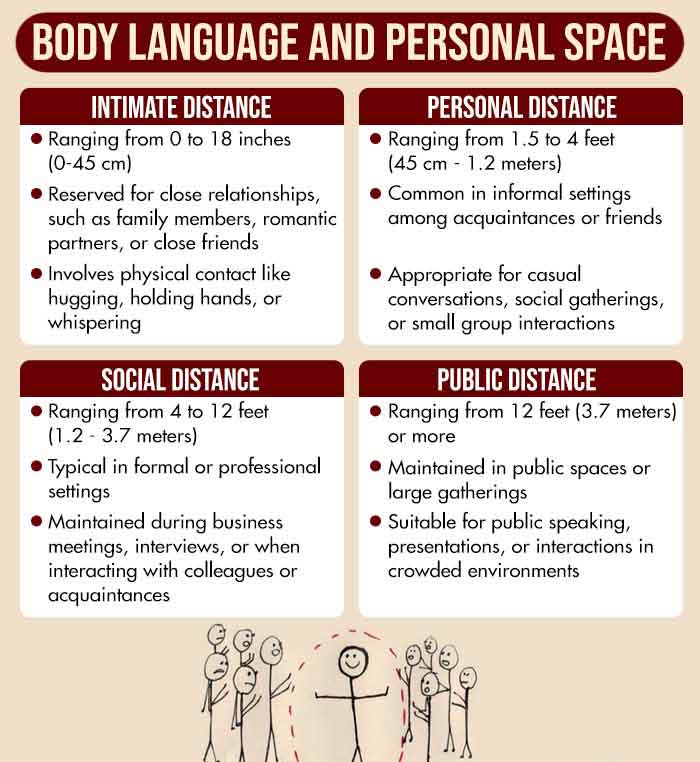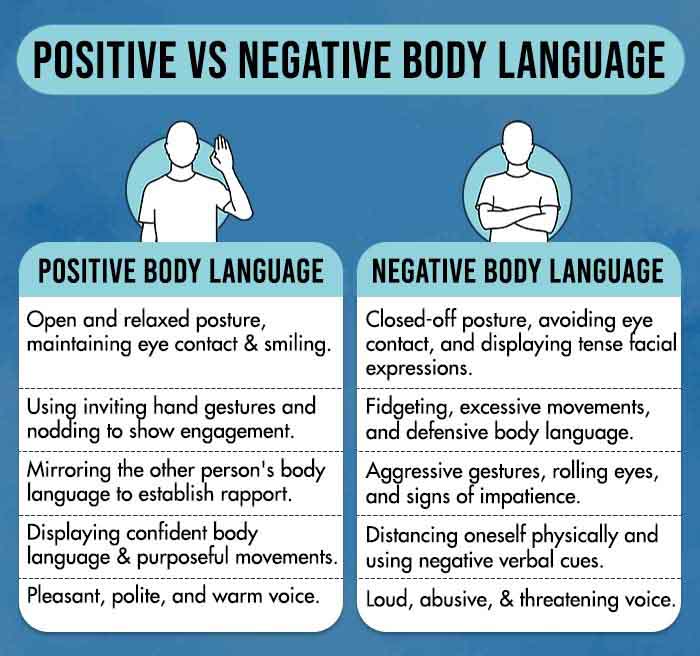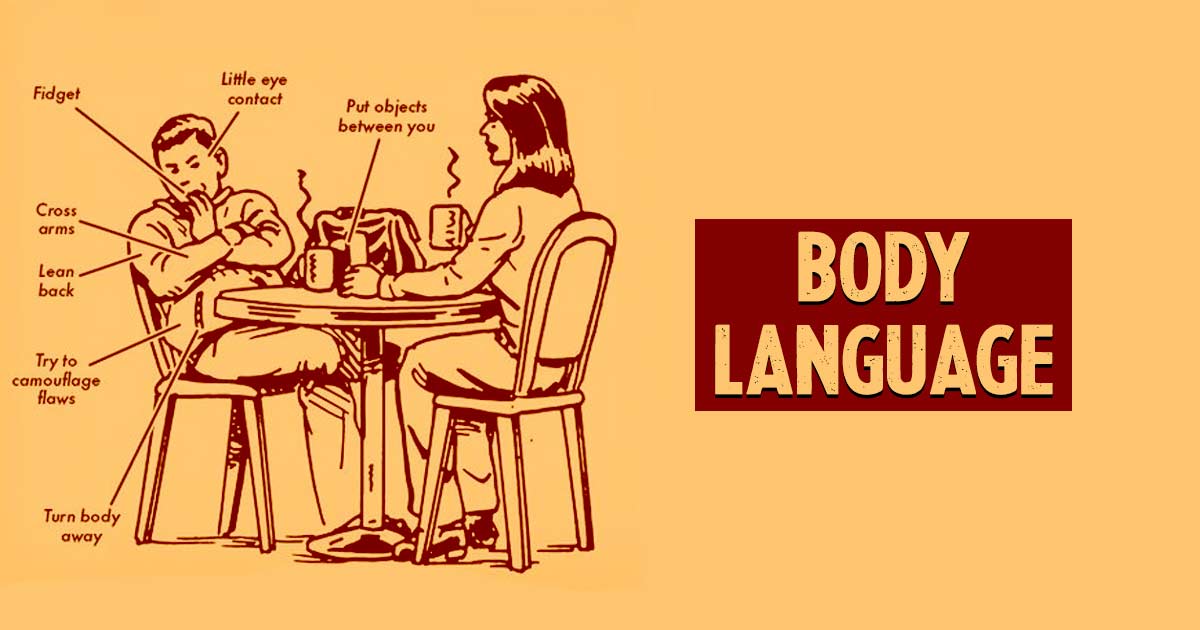Body language is a nonverbal form of communication that utilizes physical behaviors and gestures to express emotions, convey information, and communicate feelings. It is intricately intertwined with our mental and emotional well-being, impacting our self-confidence and quality of life.
What Is Body Language?
Body language refers to the nonverbal signals and cues [mfn] Vaskinn, A., Sundet, K., Østefjells, T., Nymo, K., Melle, I., & Ueland, T. (2016). Reading Emotions from Body Movement: A Generalized Impairment in Schizophrenia. Frontiers in psychology, 6, 2058. https://doi.org/10.3389/fpsyg.2015.02058 [/mfn] that individuals use to convey their thoughts, emotions, and intentions through physical gestures, facial expressions, posture, and other bodily movements.
It is a form of communication that complements and often supplements verbal communication. Body language plays a significant role in human interactions, as it can provide insight into a person’s true feelings and attitudes, even when their words may convey a different message.
The nature of body language is largely unconscious and spontaneous [mfn] Vogel, D., Meyer, M., & Harendza, S. (2018). Verbal and non-verbal communication skills including empathy during history taking of undergraduate medical students. BMC medical education, 18(1), 157. https://doi.org/10.1186/s12909-018-1260-9 [/mfn] , meaning that individuals often display nonverbal cues without deliberate intention. These cues can be highly nuanced and vary across cultures, making it essential to consider cultural contexts when interpreting body language.
Body language can also vary amongst genders [mfn] Sokolov, A. A., Krüger, S., Enck, P., Krägeloh-Mann, I., & Pavlova, M. A. (2011). Gender affects body language reading. Frontiers in psychology, 2, 16. https://doi.org/10.3389/fpsyg.2011.00016 [/mfn] . For example, studies suggest that men may display more expansive body postures to convey dominance and assertiveness. Women, on the other hand, may engage in expressive facial expressions and use more subtle gestures.
Examples of body language include a person crossing their arms, which often indicates defensiveness or a closed-off attitude. Eye contact can signal interest, attentiveness, or even deception, depending on the context and duration.
Smiling is generally associated with happiness and friendliness, while frowning or furrowing the brow may indicate confusion or displeasure. These are just a few examples of the countless nonverbal cues that individuals use to communicate their thoughts and feelings [mfn] De Stefani, E., & De Marco, D. (2019). Language, Gesture, and Emotional Communication: An Embodied View of Social Interaction. Frontiers in psychology, 10, 2063. https://doi.org/10.3389/fpsyg.2019.02063 [/mfn] .

Types Of Body Language
Research [mfn] Sandler W. (2018). The Body as Evidence for the Nature of Language. Frontiers in psychology, 9, 1782. https://doi.org/10.3389/fpsyg.2018.01782 [/mfn] categorizes the types of body language into the following:
1. Facial expressions:
The face is a primary channel for conveying emotions. Facial expressions such as smiles, frowns, raised eyebrows, and narrowed eyes can communicate happiness, sadness, surprise, anger, or confusion. For instance, a genuine smile can indicate friendliness and warmth, while a furrowed brow might suggest confusion or concern.
Read More About Anger Here
2. Gestures:
Hand movements and gestures can add emphasis, clarify meaning, or express intentions. Examples of body language in gestures include pointing, waving, thumbs-up, or crossing arms. A person waving their hand to greet someone or nodding their head in agreement are gestures that convey specific messages without the need for words.
3. Posture:
Body posture refers to the position and alignment of the body. It can reveal a person’s level of confidence, openness, or defensiveness. For example, standing tall with shoulders back and head held high often indicates confidence, while slouched shoulders and a hunched back may imply insecurity or low self-esteem.
Read More About Self-Esteem Here
4. Eye contact:
The way individuals engage or avoid eye contact can convey various meanings. Sustained eye contact typically signals attentiveness, interest, and confidence. Conversely, avoiding eye contact may suggest shyness, discomfort, or lack of confidence. However, it is essential to consider cultural variations in eye contact norms.
5. Touch:
Touch can communicate a range of emotions and intentions, depending on the context and culture. A gentle touch on the arm can convey empathy or reassurance, while a firm handshake can express confidence and assertiveness. Touch can also signal affection, support, or boundary violation, and its interpretation varies across individuals and cultural backgrounds.
Read More About Empathy Here
6. Voice:
Vocal cues such as tone, pitch, volume, and pacing contribute to nonverbal communication. A soft, soothing voice can convey empathy or comfort, while a loud and assertive voice may express authority or dominance. Voice modulation can convey enthusiasm, sarcasm, or uncertainty, adding layers of meaning to spoken words.

Body Language And Mental Health
Body language and mental health are intricately related [mfn] Abdulghafor, R., Turaev, S., & Ali, M. A. H. (2022). Body Language Analysis in Healthcare: An Overview. Healthcare (Basel, Switzerland), 10(7), 1251. https://doi.org/10.3390/healthcare10071251 [/mfn] , with the former profoundly impacting social interactions and emotional well-being. Positive body language, including open postures, eye contact, and appropriate gestures, enhances self-confidence, self-esteem, and empowerment. It facilitates effective communication, builds rapport, and fosters meaningful social connections.
Conversely, negative examples of body language (such as crossed arms, avoiding eye contact, or fidgeting) can signal insecurity, anxiety, and discomfort, leading to feelings of low self-esteem and increased stress levels.
Developing and practicing effective body language skills can greatly improve mental well-being by enhancing self-perception, promoting positive social relationships, and reducing social anxiety.
Read More About Anxiety Here
How Do Mental Health Disorders Influence Body Language?
Mental illnesses can significantly influence [mfn] Foley, G. N., & Gentile, J. P. (2010). Nonverbal communication in psychotherapy. Psychiatry [Edgmont (Pa. : Township)], 7(6), 38–44. [/mfn] body language, resulting in observable changes in posture, gestures, and facial expressions. Individuals with anxiety disorders may display body language cues like fidgeting, restlessness, and avoiding eye contact. Depression can manifest through slumped posture, lack of facial expressions, and slowed movements, conveying low energy and diminished interest.
Social phobia can lead to defensive body language as a means of protecting oneself from perceived threats or judgment, often resulting in social avoidance.
Psychotic disorders, such as schizophrenia, can cause abnormal body movements or postures, including repetitive gestures or unusual facial expressions. These changes in body language associated with mental illness can further contribute to stigma and social exclusion.
How To Read Body Language
Consider the following tips [mfn] Hills L. (2011). Reading and using body language in your medical practice: 25 research findings. The Journal of medical practice management : MPM, 26(6), 357–362. [/mfn] on how to read body language:
- Observe facial expressions. Watch for changes in eyebrows, eyes, and mouth.
- Notice gestures and movements. Pay attention to hand movements, arm gestures, and body shifts.
- Consider posture and body positioning. Assess if someone is standing tall with an open posture or slouching with crossed arms.
- Focus on eye contact. Observe the duration and intensity of eye contact.
- Interpret proximity and personal space. Note the distance between individuals during interactions.
- Pay attention to vocal cues. Listen for tone of voice, pitch, and pace.
- Watch for micro expressions. Look for fleeting facial expressions that reveal true emotions.
- Consider clusters of body language. Analyze the consistency or inconsistencies in different cues.
- Account for cultural differences [mfn] Resat, F. A. (2019). Body Language of Culture. International Journal for Innovation Education and Research, 7(8), 32–39. https://doi.org/10.31686/ijier.vol7.iss8.1639 [/mfn] . Be aware of cultural norms and context when interpreting nonverbal communication.
How To Improve Body Language
Consider the following tips [mfn] Sharma, N., & Gupta, V. (2023). Therapeutic Communication. PubMed; StatPearls Publishing. Available from: https://www.ncbi.nlm.nih.gov/books/NBK567775/ [/mfn] on how to improve body language:
- Maintain good posture, standing tall with relaxed shoulders and a straight back.
- Make appropriate eye contact to convey attentiveness and engagement.
- Use open gestures, avoiding crossed arms or hands in pockets.
- Show genuine facial expressions and smile to enhance communication and connection.
- Practice mirroring subtle body language to establish rapport and connection with others.
- Respect personal space and maintain an appropriate distance during interactions.
- Project confidence through steady and purposeful body language, including a confident gait and upright posture.
- Practice active listening by nodding, using facial expressions, and providing verbal cues.
- Seek feedback from trusted individuals to improve body language.
- Observe and analyze your own body language through mirror practice or recording yourself.
Takeaway
Understanding and interpreting the different types of body language is a vital aspect of communication, enabling us to comprehend and grasp the messages conveyed by others.
Rather than dissecting individual nonverbal gestures, it is crucial to consider them within the context of the situation. Enhancing our nonverbal communication skills can have a profound impact, allowing us to effectively convey information and emotions without uttering a single word.
At A Glance
- Body language is a nonverbal form of communication that uses physical behaviors and gestures to express emotions, convey information, and communicate feelings.
- The common types of body language comprise facial expressions, gestures, posture, eye contact, touch, and voice.
- Popular examples of body language include a person crossing their arms, avoiding eye contact, fidgeting, etc.
- Body language and mental health are intricately woven, each impacting the other.
- Understanding how to improve body language can enhance communication, build rapport, and positively impact mental health and well-being.
- While considering the measures on how to read body language, one should take into account cultural norms and contexts of nonverbal cues.
Frequently Asked Questions (FAQs)
1. What Are The 4 Main Types Of Body Language?
The four main types of body language are facial expressions, gestures, posture, and eye contact.
2. How Does Body Language Impact Our Daily Life?
Body language impacts our daily life by influencing how others perceive us, shaping our communication and relationships, and revealing our emotions and intentions.
3. Which Mental Health Disorders Are Associated With Negative Body Language?
Body language and mental health are inversely related, as mental health disorders like social anxiety disorder, depression, and post-traumatic stress disorder (PTSD) are associated with negative body language.










